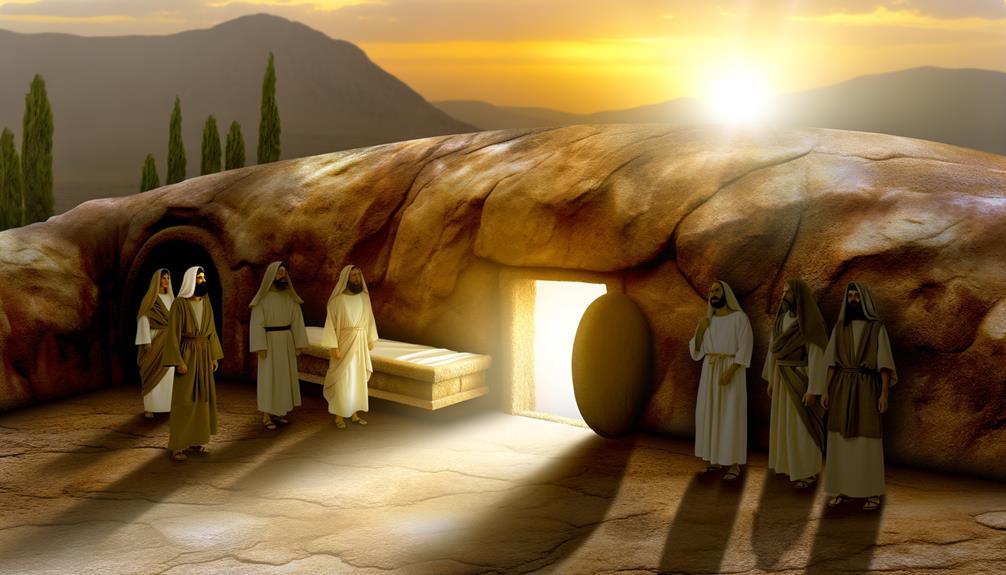He Is Risen Bible Verse Meaning: Victory Over Death
The phrase ‘He Is Risen‘ from the New Covenant Gospels, particularly Matthew 28:6, Mark 16:6, and Luke 24:6, signifies the physical resurrection of Jesus Christ and is a cornerstone of Christian doctrine. It underscores divine triumph over sin and death, fulfilling Old Covenant prophecies and validating Christ’s messianic mission.
The Greek verb ‘ēgerthē’ emphasizes divine agency, making the resurrection both a historical and theological assertion. This proclamation transformed early Christian belief, emboldening their faith and catalyzing the spread of the Gospel.
For a deeper understanding of its profound implications, further examination of scriptural narratives and theological interpretations is essential.

He Is Risen Bible Verse Meaning: The Power of Christ’s Resurrection and Its Significance
| Aspect | Description |
|---|---|
| Key Bible Verse | Matthew 28:6 – “He is not here; He has risen, just as He said. Come and see the place where He lay.” |
| Biblical Context | Spoken by the angel to the women at Jesus’ empty tomb after His crucifixion, announcing His resurrection. |
| Spiritual Meaning | Declares Jesus’ victory over sin and death, affirming His divine nature and the fulfillment of His promise. |
| Significance in Christianity | The foundation of Christian faith, symbolizing hope, redemption, and the assurance of eternal life. |
| Fulfillment of Prophecy | Jesus’ resurrection fulfills Old Testament prophecies about the Messiah’s triumph over death (Psalm 16:10, Isaiah 53:10-11). |
| Theological Importance | Confirms Jesus as the Son of God and validates His teachings about salvation and eternal life (Romans 1:4). |
| Practical Application | Inspires faith, hope, and courage, reminding believers of the power of God to bring new life and transformation. |
| Connection to Salvation | Through His resurrection, Jesus conquered sin, offering forgiveness and eternal life to all who believe (1 Corinthians 15:17). |
| Biblical Examples | John 20:19-29 (Jesus appears to the disciples), Luke 24:13-35 (Road to Emmaus), Acts 1:3 (Jesus’ post-resurrection appearances). |
| Related Biblical Concepts | Resurrection, Salvation, Eternal Life, Redemption, Victory Over Death, Hope, New Life, Faith in Christ. |
Scriptural Origins of ‘He Is Risen’

The phrase ‘He is risen‘ originates from the canonical Gospels of the New Scriptures, particularly reflected in the resurrection narratives found in Matthew 28:6, Mark 16:6, and Luke 24:6. These verses collectively underscore the transformative event of Jesus Christ’s resurrection, central to Christian theology.
The Greek verb ‘ἠγέρθη’ (ēgerthē) used in these passages signifies not only the act of rising but also implies divine agency. This term encapsulates both the physical resurrection and its theological implications, emphasizing divine intervention and fulfillment of prophecy.
The repetitive affirmation across these Gospels underscores its doctrinal importance, heralding the defeat of death and the promise of eternal life. Consequently, ‘He is risen’ functions as both a declaration of faith and a cornerstone of Christian doctrine.
Resurrection in the Gospels

Building upon the scriptural origins, the Resurrection narratives in the Gospels provide a multifaceted portrayal of this pivotal event, each contributing unique theological and narrative elements.
Matthew emphasizes the miraculous with an earthquake and angelic appearance, reinforcing Jesus’ divine authority.
Mark presents a more enigmatic account, ending abruptly to leave readers contemplating the awe and fear of the empty tomb.
Luke offers a detailed and orderly narrative, highlighting the physicality of the risen Christ and His appearances.
John’s account is deeply personal, focusing on individual encounters such as with Mary Magdalene and Thomas, underscoring themes of belief and recognition.
Collectively, these accounts furnish a thorough theological tapestry that enriches the understanding of the Resurrection’s significance.
Old Testament Foreshadowing

The Old Covenant contains numerous prophetic texts and symbolic actions that prefigure the resurrection of Christ, especially through messianic prophecies and the symbolism of the sacrificial lamb.
These elements collectively foreshadow the pivotal role of Jesus as the anticipated Messiah and the ultimate sacrifice for humanity’s redemption.
Analyzing these foreshadowings provides a deeper understanding of how the resurrection fulfills ancient scriptural promises.
Prophecies of the Messiah
Throughout the Old Covenant, numerous prophecies foreshadow the coming of the Messiah, establishing a foundation for the New Covenant’s proclamation of Jesus’ resurrection.
These prophetic texts provide not only a predictive framework but also a theological context for understanding the significance of Christ’s life, death, and resurrection.
Key prophetic references include:
- Isaiah 53:3-5: Describes the suffering servant, interpreted as the Messiah.
- Psalm 22: Foretells the anguish and ultimate triumph of the righteous sufferer.
- Daniel 9:25-26: Predicts the exact timing of the Messiah’s arrival and his subsequent “cutting off.”
- Micah 5:2: Prophesies the birthplace of the Messiah in Bethlehem.
These scriptures collectively underscore the anticipated fulfillment found in Jesus Christ.
Sacrificial Lamb Symbolism
Integral to the prophetic anticipation of the Messiah, the symbolism of the sacrificial lamb in the Old Scriptures serves as a profound foreshadowing of Jesus Christ’s atoning sacrifice.
The Passover lamb in Exodus 12, whose blood marked the homes of Israelites to save them from judgment, prefigures Christ’s sacrificial death.
Isaiah 53 further amplifies this imagery, depicting the Messiah as a ‘lamb led to the slaughter,’ underscoring His role as the ultimate atonement for sin.
The sacrificial system described in Leviticus, with its emphasis on unblemished offerings, also anticipates the sinless nature of Christ.
Consequently, these Old Covenant motifs collectively point to Jesus as the fulfillment of divine redemption, encapsulating the theological essence of His resurrection.
Theological Significance

The theological significance of the phrase ‘He is risen‘ encompasses critical elements of Christian doctrine, such as the resurrection’s role in human salvation, the fulfillment of ancient prophecy, and the promise of eternal life.
The resurrection serves as a pivotal event affirming Jesus’ divine nature and his victory over sin and death, consequently offering believers the hope of their own resurrection.
Additionally, this event validates prophetic scriptures and provides the cornerstone for the eschatological hope that underpins Christian faith. The belief that these prophecies will come to fruition inspires a profound sense of purpose and direction among believers. Moreover, the esmeralda symbolism in biblical context reflects the richness of God’s promises, as emeralds are often associated with renewal and divine love, reminding the faithful of their covenant relationship with Him. As such, these symbols serve not only as reminders of God’s faithfulness but also as beacons of hope for those seeking understanding in turbulent times.
Resurrection and Salvation
Central to Christian theology, the resurrection of Jesus Christ underpins the doctrine of salvation, signifying the triumph over sin and death and offering believers the promise of eternal life. This foundational event is not merely historical but carries profound theological implications:
Victory Over Sin: The resurrection demonstrates Christ’s power to forgive sins.
Defeat of Death: It signifies the overcoming of physical and spiritual death.
Promise of Eternal Life: Believers are assured of their own resurrection and eternal life.
Reconciliation with God: It restores the broken relationship between humanity and God.
Foundation of Christian Hope: The resurrection is the cornerstone of the Christian faith, providing a basis for hope and perseverance.
Through these dimensions, the resurrection affirms the extensive scope of salvation.
Fulfillment of Prophecy
Fulfillment of prophecy in the resurrection of Jesus Christ underscores a significant aspect of biblical theology by confirming scriptural predictions and validating the divine nature of Christ’s mission.
Numerous Old Covenant prophecies, such as Isaiah 53:10-11 and Psalm 16:10, foretell the Messiah’s suffering, death, and subsequent triumph over the grave. The precise fulfillment of these prophecies in the New Testament narrative demonstrates the coherence and reliability of biblical revelation.
In addition, it affirms Jesus as the prophesied Savior, whose resurrection embodies divine power and authenticity. This fulfillment not only reinforces the credibility of the Scriptures but also provides a theological cornerstone for the Christian faith, emphasizing God’s sovereign plan and the ultimate victory over sin and death.
Eternal Life Promise
Building upon the affirmation of prophecy, the resurrection of Jesus extends beyond historical validation to embody the theological promise of eternal life for believers. This pivotal event is foundational, revealing profound implications for Christian eschatology and soteriology.
The resurrection signifies:
- Victory over death: Affirming the defeat of mortality through divine intervention.
- Assurance of salvation: Establishing a secured pathway to eternal communion with God.
- Reconciliation with God: Embodied in the risen Christ as the mediator of a new covenant.
- Transformative hope: Offering believers a future-oriented perspective grounded in divine promise.
These elements collectively articulate the resurrection’s role in promising eternal life, underpinning core Christian doctrines and personal faith.
Impact on Early Christians

The proclamation ‘He is risen‘ profoundly transformed the theological foundation and communal practices of early Christians, catalyzing a newfound sense of hope and mission.
This declaration affirmed the divinity of Jesus and validated His teachings, thereby solidifying the core tenet of resurrection within Christian doctrine. It engendered a vigorous evangelistic zeal, as believers perceived the resurrection as a triumph over death and a promise of eternal life.
Consequently, communal worship evolved to emphasize the Eucharist, commemorating Christ’s victory. Additionally, this belief emboldened early Christians to face persecution, as the resurrection underscored the transient nature of earthly suffering compared to eternal glory.
As a result, ‘He is risen’ was instrumental in shaping the identity and resilience of early Christian communities.
Symbolism of the Empty Tomb

The empty tomb stands as a profound symbol of victory over death, illustrating the triumph of life and resurrection.
This event not only signifies the defeat of mortality but also serves as the fulfillment of Old Scriptures prophecies, reinforcing the messianic identity of Jesus.
Victory Over Death
By examining the symbolism of the empty tomb, one can discern the profound theological assertion of victory over death inherent in the Christian resurrection narrative. This symbolism encapsulates several key elements:
- Defeat of Mortality: The empty tomb signifies Christ’s triumph over death, affirming the Christian belief in eternal life.
- Hope and Renewal: It embodies the promise of new beginnings and the possibility of spiritual renewal.
- Divine Power: The resurrection event underscores the omnipotence of God, who alone has authority over life and death.
- Validation of Faith: The empty tomb serves as tangible evidence supporting the foundational claims of Christianity.
This multifaceted symbolism enriches the understanding of Christian eschatology.
Fulfillment of Prophecy
Central to the Christian understanding of the empty tomb is its role in fulfilling ancient prophecies, thereby reinforcing the divine legitimacy of Christ’s resurrection. The empty tomb epitomizes the realization of Old Scriptures predictions, highlighting a divine orchestration that surpasses human comprehension. These prophecies, meticulously chronicled, are not mere coincidences but deliberate affirmations of Jesus’ messianic identity and divine mission.
| Prophecy | Fulfillment |
|---|---|
| Psalm 16:10 | Resurrection prefigured |
| Isaiah 53:9 | Burial in a rich man’s tomb (Joseph of Arimathea) |
| Hosea 6:2 | Raised on the third day |
| Jonah 1:17 | Jonah’s three days in the whale as a typology |
This prophetic fulfillment underscores the theological assertion that Jesus’ resurrection is divinely ordained, validating Christian eschatological hope.
Victory Over Death

Through His resurrection, Christ’s triumph over death symbolizes the ultimate victory for humanity, offering hope and the promise of eternal life. This pivotal event underscores the theological foundation that death is not the end but a passage to a new existence.
The resurrection narrative provides several key insights:
- Divine Power: Demonstrates God’s supreme authority over life and death.
- Redemption: Guarantees the forgiveness of sins and the possibility of reconciliation with God.
- New Life: Embodies the concept of rebirth and spiritual renewal.
- Eschatological Promise: Foretells the eventual resurrection of all believers.
These elements collectively affirm the profound implications of Christ’s resurrection.
Hope and Assurance

The resurrection of Christ not only signifies victory over death but also instills profound hope and assurance in believers, affirming the reliability of God’s promises and the certainty of eternal life.
This pivotal event underscores the theological conviction that God’s power transcends human mortality. Scriptural references such as 1 Peter 1:3 emphasize being ‘born again to a living hope through the resurrection of Jesus Christ from the dead.’
This hope is not mere optimism but a steadfast assurance rooted in divine fidelity. In addition, the resurrection validates the eschatological promise, providing believers with a foretaste of their own resurrection and eternal communion with God.
Consequently, it cultivates a resilient faith, grounded in the transformative power of the risen Christ.
Fulfillment of Prophecy

Integral to understanding the resurrection of Christ is recognizing its role in fulfilling ancient prophecies, thereby confirming the veracity of scriptural revelations. Various Old Testament scriptures foretold the Messiah’s resurrection, providing a foundation for its anticipated occurrence.
By examining these prophecies, one can appreciate the continuity and coherence of biblical narratives. Some key messianic prophecies include:
- Psalm 16:10: ‘For You will not abandon my soul to Sheol; Nor will You allow Your Holy One to undergo decay.’
- Isaiah 53:10: ‘He will see His offspring and prolong His days.’
- Hosea 6:2: ‘On the third day He will raise us up.’
- Jonah 1:17: Jonah’s three days in the whale as a typology.
This prophetic fulfillment underscores the reliability and divine inspiration of biblical texts.
Implications for Believers

Recognizing the fulfillment of prophecy through Christ’s resurrection, believers are called to reflect on its profound implications for their faith and daily lives.
This pivotal event signifies the triumph over sin and death, affirming the promise of eternal life and solidifying the foundation of Christian hope.
It compels believers to live in a manner that embodies the transformative power of resurrection, promoting moral integrity, spiritual growth, and communal harmony.
Additionally, it serves as a call to witness, urging believers to proclaim the resurrection’s significance in word and deed.
Consequently, the resurrection not only validates Christian doctrine but also mandates an active, faith-driven response that influences ethical decisions and interactions within the broader community.
Contemporary Relevance

In today’s rapidly changing world, the resurrection narrative continues to hold profound significance for modern believers, influencing both personal spirituality and broader cultural dynamics. This timeless message resonates deeply, providing a foundation for faith and practice.
Its contemporary relevance can be analyzed through several dimensions:
- Hope and Renewal: The resurrection symbolizes new beginnings and the possibility of transformation.
- Moral Framework: It offers ethical guidance, emphasizing forgiveness and compassion.
- Community Building: Shared belief in the resurrection fosters a sense of belonging and unity.
- Cultural Impact: Art, literature, and media frequently draw from resurrection themes.
These facets underscore the enduring importance of the resurrection in today’s context.
Conclusion
The phrase ‘He is risen,’ a cornerstone of Christian theology, emanates from scriptural, prophetic, and theological roots, serving as an emblem of hope and divine assurance.
Its profound impact on early Christians and its continued relevance today underscore its essential role in faith.
One might even surmise that without this resurrection narrative, the Christian doctrine would be merely a collection of moral aphorisms, lacking the triumphant crescendo that gives it purpose and energy.






